
Analyzing Odisha FC's remarkable evolution under Sergio Lobera | ISL 2023-24
Making history and defying the odds has become the norm at Odisha FC recently. In conjunction with the state's transformation into a focal point for Indian football, the club’s success stands as a cornerstone in propelling the sport in the eastern region of the country.
But Odisha FC's ascent to prominence has unfolded slowly. Initial seasons witnessed the club finishing in the lower half of the table, as they struggled to establish a distinct identity.
The narrative underwent a dramatic shift last season, with the club securing a top-six finish and clinching a spot in the ISL’s knockout rounds for the first time in their history.
A mere month later, the Kalinga Warriors orchestrated a remarkable campaign under Clifford Miranda’s guidance, defying all expectations to clinch the Super Cup. This triumph not only marked the club’s maiden trophy but also ensured a coveted place on the continental stage.
In the wake of resounding success and heightened aspirations, Odisha FC invested heavily in the summer, with the marquee acquisition being the appointment of Sergio Lobera.
While the start to the season was sluggish, the Juggernauts currently find themselves on a roll, having not only secured a berth in the AFC Cup knockout rounds but also consistently challenging the top teams in the Indian Super League. What was once a fanciful ambition has crystallized into tangible success in the heart of Bhubaneswar.
At the epicenter of this success stands Lobera, whose teams tend to dominate matches and achieve positive results by playing an attractive brand of football.
With that in mind, let’s delve into the Spanish coach’s tactical approach, his impact, and how he’s creating an identity at the club.
The set up
Following the acquisition of Lobera, Odisha FC went all out in the transfer market to secure the players integral to his vision. This required moves to recruit talent from other ISL clubs, ensuring that the head coach had the tools to make an immediate impact.
The summer spending spree started with the signing of Mumbai City FC’s star players Ahmed Jahouh and Mourtada Fall, both of whom had previously thrived under Lobera at FC Goa and Mumbai City.
Expanding their focus to Indian prospects, Odisha FC secured Amey Ranawade and Lenny Rodrigues, both familiar with Lobera’s coaching. Additionally, they bolstered their depth with the additions of Puitea, Jerry Lalrinzuala, and Laldinliana Rentheli.
Towards the end of the window, Odisha FC sealed deals for two foreign players - Cy Goddard, who had played under Lobera at Mumbai, and Roy Krishna, the fourth-highest goal scorer in the ISL.
This approach in the transfer window significantly improved both the quality and depth of the squad. Complementing the new signings, Odisha FC also had a mix of seasoned players and emerging talents who had previously showcased their potential during Josep Gombau’s tenure.
Lobera continued to adopt a 4-2-3-1 system on paper, as it aligned with the skill sets of the recruited players. Amrinder Singh has been the undisputed goalkeeper, while Ranawade and Jerry have operated as full-backs on the right and left sides, respectively. The center-back pairing has featured Narender Gahlot alongside Carlos Delgado, while Lobera has also started both foreign center-backs at times.
In midfield, the duo of Jahouh and Puitea have been undroppable, while Rodrigues and Goddard have alternated for the third midfield position. Odisha FC’s emerging talents - Jerry Mawihmingthanga and Isak Vanlalruatfela - have displayed noteworthy progress under Lobera’s tutelage, and they have supported either Diego Mauricio or Krishna in the attacking department.
The system
In typical Lobera fashion, Odisha FC shift from a 4-2-3-1 shape on paper to a back three in possession. Jahouh usually drops between the two center-backs or positions himself on either side, while the other midfielders drop deeper, establishing a 3-2 shape in the first line. Given the prevalent defensive approach in the ISL, where teams often press with one or two forwards, this creates a numerical advantage in the first phase.
But notably, the midfielders in front of the back three have varying line heights, with one of the midfielders positioned higher and wider to provide a passing option for a center-back. A situational back three also facilitates Odisha’s attack-minded full-backs, Ranawade and Jerry, to advance and hold the width, while the wingers drift inside to support the No. 9.
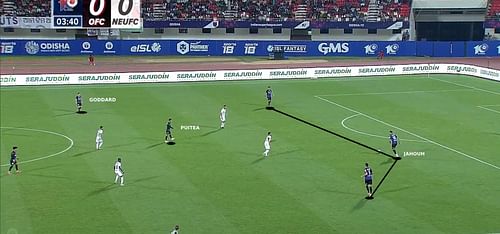
Odisha FC prefer to have an additional player in the first phase when teams press higher up the pitch. However, when an opponent sits back and invites pressure, they are extremely aggressive in committing men forward.
The scenario against Hyderabad FC (below) depicts Odisha pinning their opponent back and creating overloads against a settled defensive shape. Both full-backs push higher up the pitch, with the Juggernauts holding a clear five-versus-four advantage in Hyderabad’s last line of defense.
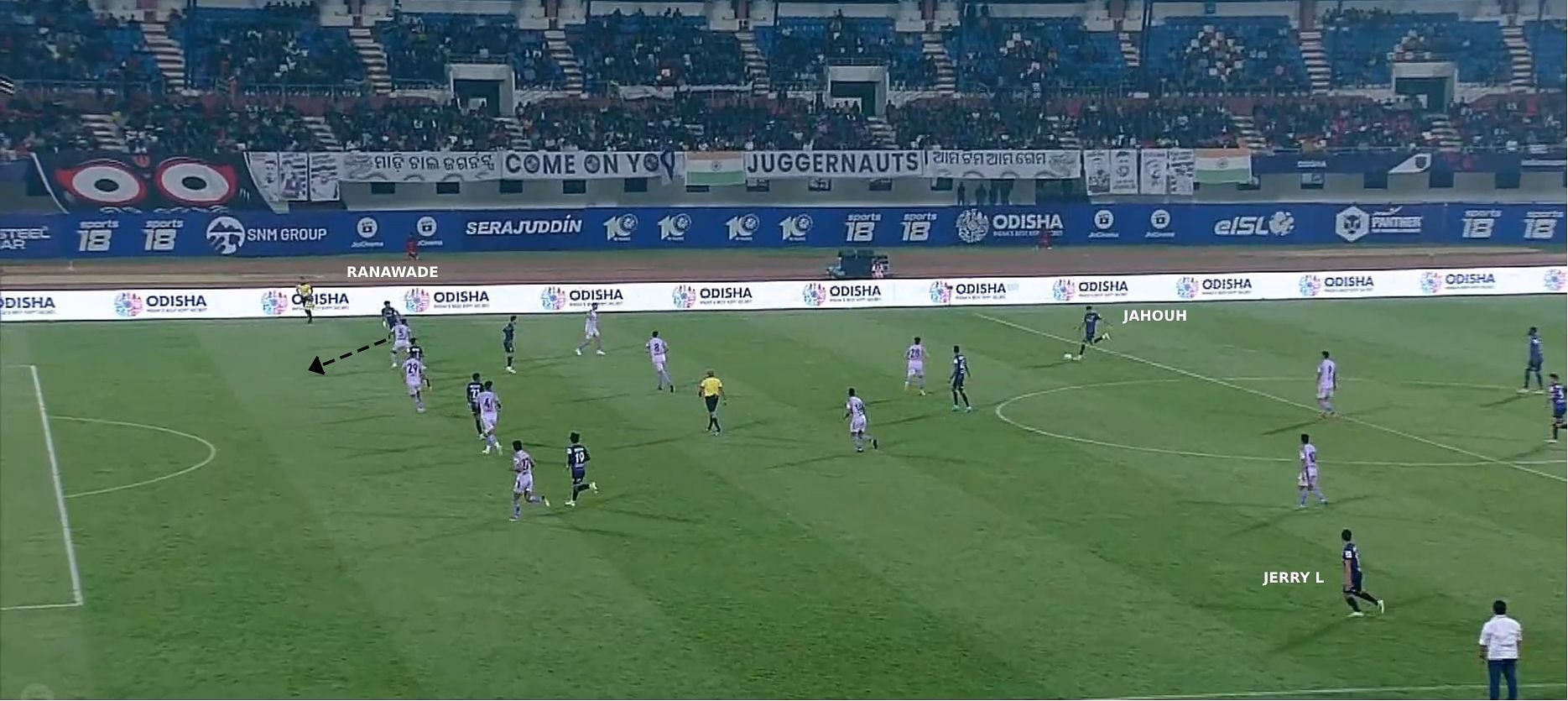
Ahmed Jahouh – The key to Odisha FC’s success
Central to this assertive approach is the pivotal role played by Jahouh. The 35-year-old serves as Odisha FC’s metronome, and the team relies on his precision in delivering accurate passes, along with impeccable timing. Jahouh stands top of the charts in terms of progressive passing in the ISL, thanks to his ability to drop alongside the center-backs and look for options in front of him.
His final third entries plot unveils the proficiency with which Jahouh executes diagonal passes from a deeper position. His ability to consistently find wide players bypasses the entire midfield of the opponent, facilitating Odisha’s entry into the final third with greater efficiency.
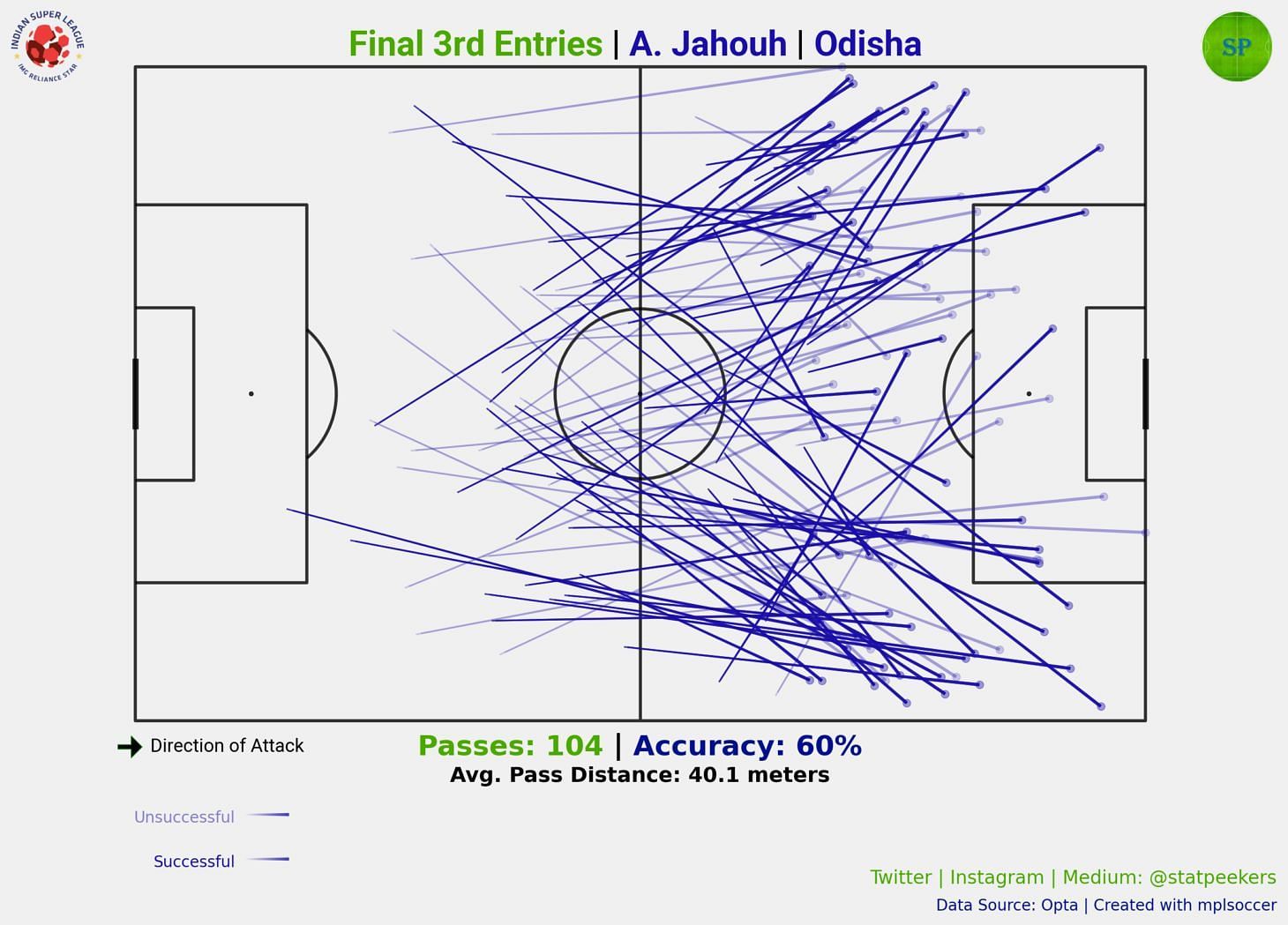
Variations in the buildup and final third
Odisha FC’s tactical dynamics on both flanks are different, which poses a challenge for opponents. Their strength lies in luring opposing teams out of their defensive structure and consistently gaining a numerical advantage in the wide regions.
On the left side, Jerry adopts a slightly deeper position compared to Ranawade, who advances higher up the pitch to maintain width. This choice is usually influenced by Odisha’s left-side dynamics, where positional rotations are integral to disrupting opponents.
The below situation against Mumbai City serves as an example of what Odisha FC does best. With Jahouh opting to remain centrally positioned, Odisha utilized Amrinder Singh in the build-up, contributing as part of the back three against Mumbai’s front two. This facilitates Puitea moving wider and rotating with Jerry.
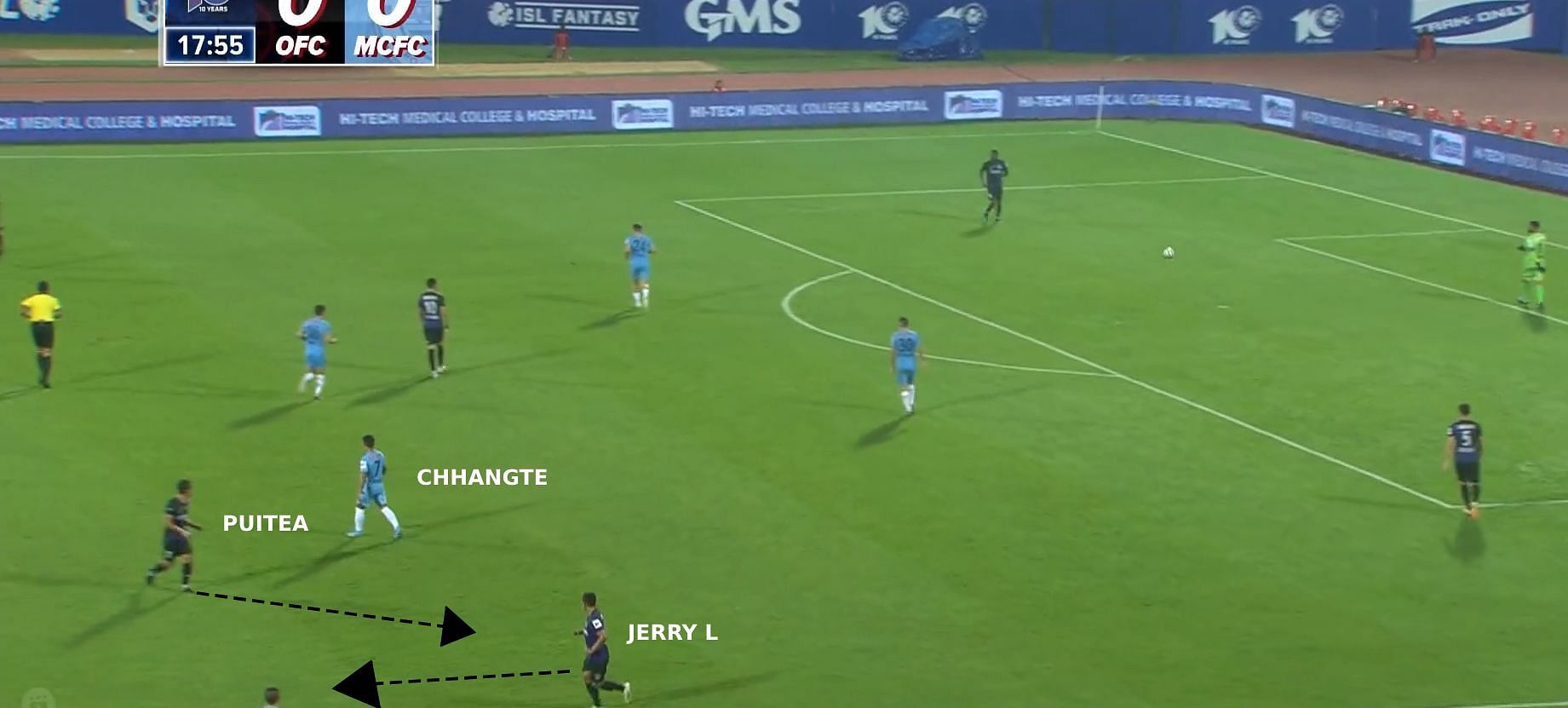
With Puitea now playing as a situational left-back, Jerry has the freedom to push higher up the pitch, which allows Isak Ralte (winger) to drift inside. In response, Chhangte, who is marking Puitea, follows suit, resulting in an opening in the central area that disrupts Mumbai’s compact structure.
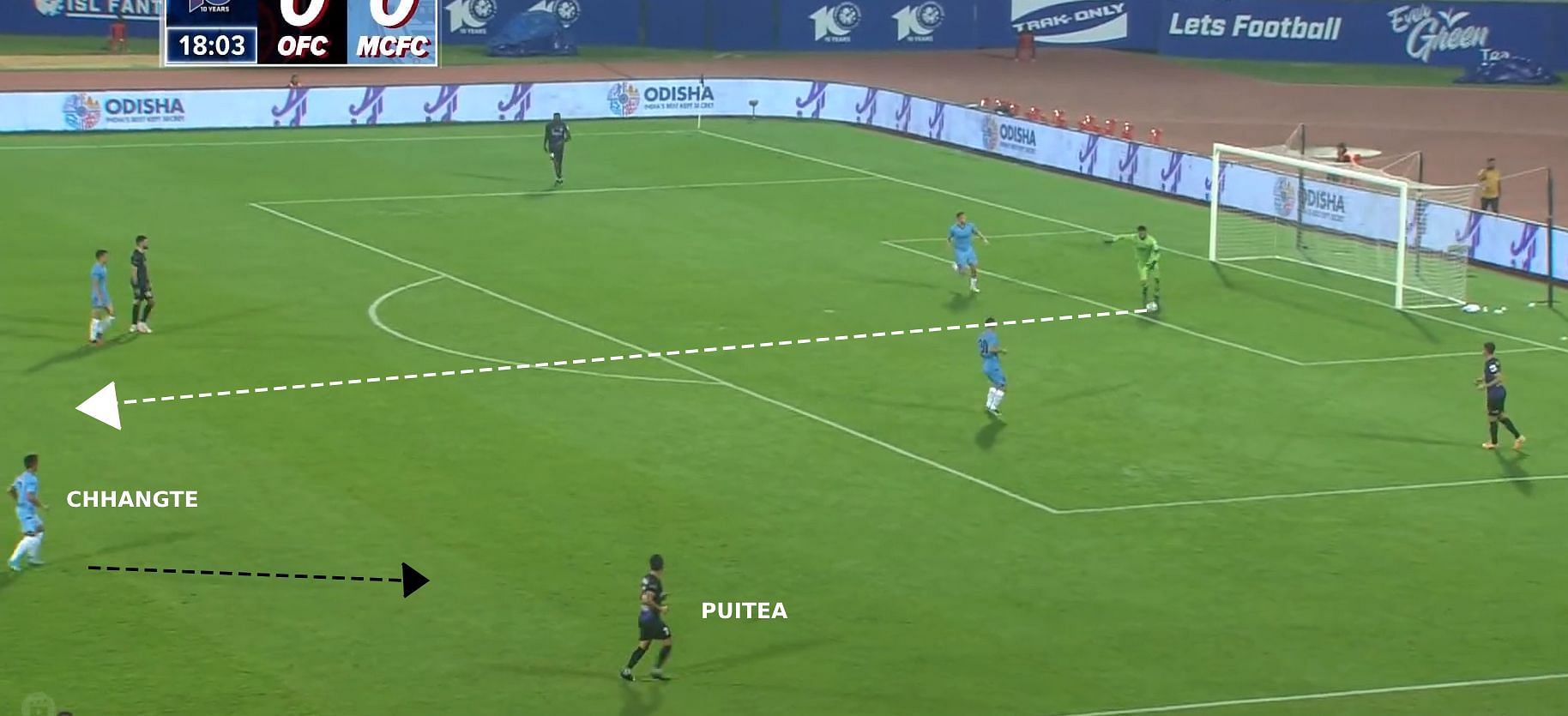
Amrinder picks a pass centrally and Mumbai’s right-back Rahul Bheke cannot follow Isak, as there is a two-versus-one situation on the flank, with Jerry moving high and wide.
Consequently, Odisha broke Mumbai’s compact midfield and created a four-versus-four situation. Lobera’s men capitalize on their opponents by using strategic rotations and width utilization from various players, here, starting with Ralte and then seamlessly transitioning to Jerry.
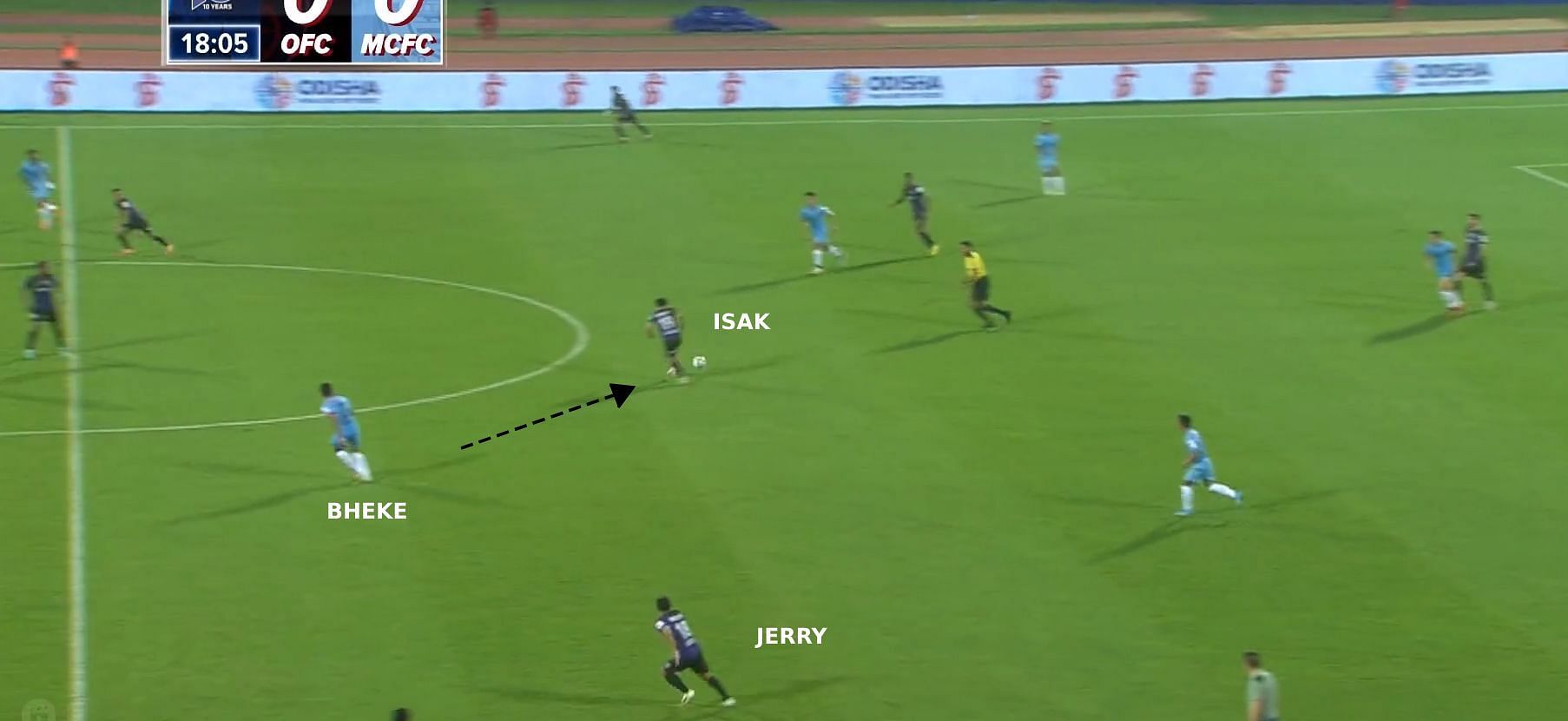
Typically, on the right flank, Ranawade takes on the role of making penetrating runs behind the opposing defense. As Odisha FC’s primary creative force from the right, he has already contributed two goals and two assists in all competitions. His first goal for Odisha, executed in classic Lobera style, occurred against Bengaluru FC.
In a specific instance, Bhumij, operating as a winger, shifts inward, enticing BFC’s center-back out of position. Ranawade cleverly makes a run into the vacated space, which is identified and exploited by Goddard. This sequence ends with Ranawade breaking through on goal and successfully scoring.
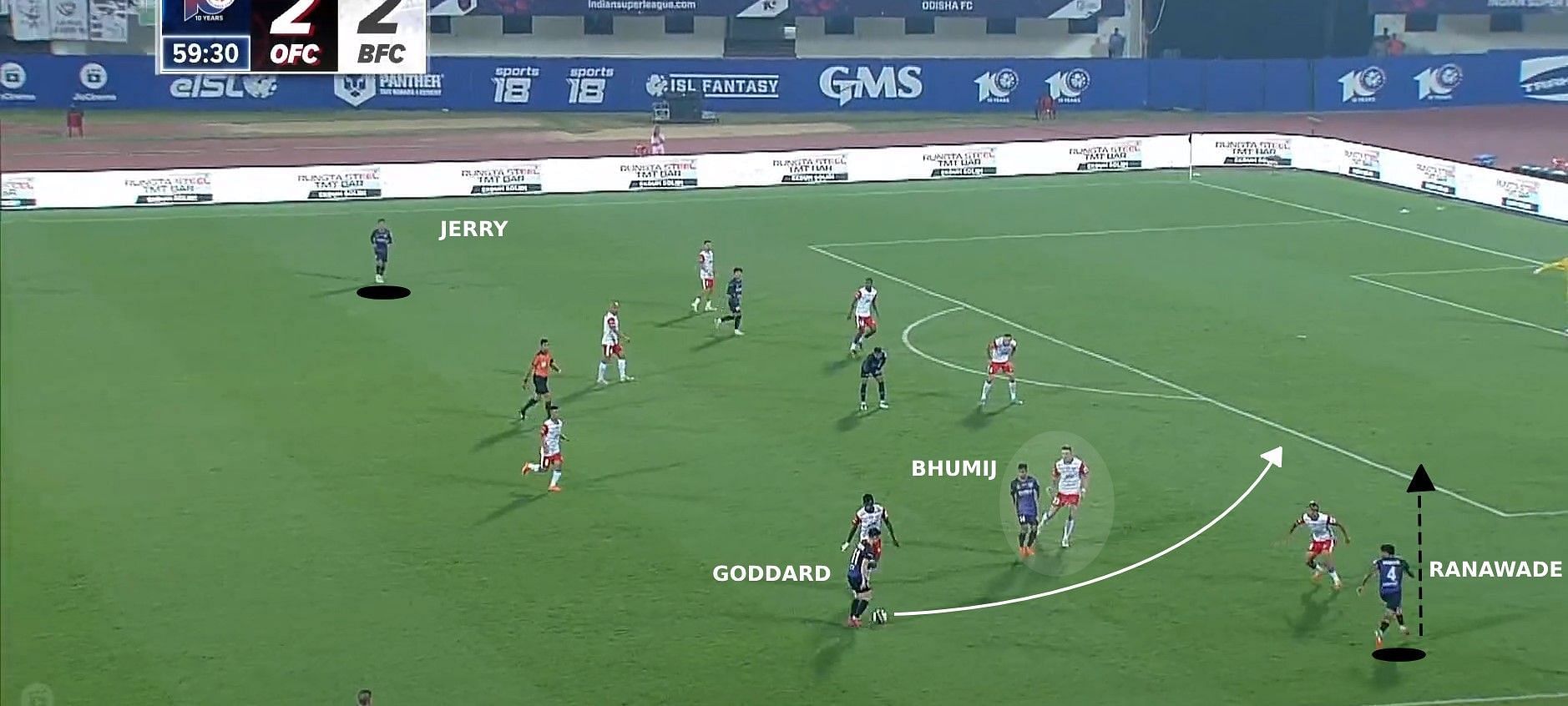
Lobera’s influence has not only transformed the team’s structure but has also brought about significant improvements individually. A prime example of this progression is evident in the development of 22-year-old Isak Ralte, particularly in terms of refining little details that make the difference. The first goal for Odisha FC against Hyderabad FC perfectly illustrates the growth of the young winger.
In this situation, Krishna drops deeper to receive the ball, scanning for available options. Isak, with astute awareness, starts from a wide position and cleverly manipulates his marker, Poojary. He executes an outward-to-inward movement, creating separation from his marker, and receives the ball on his stronger right foot to drift centrally into space.
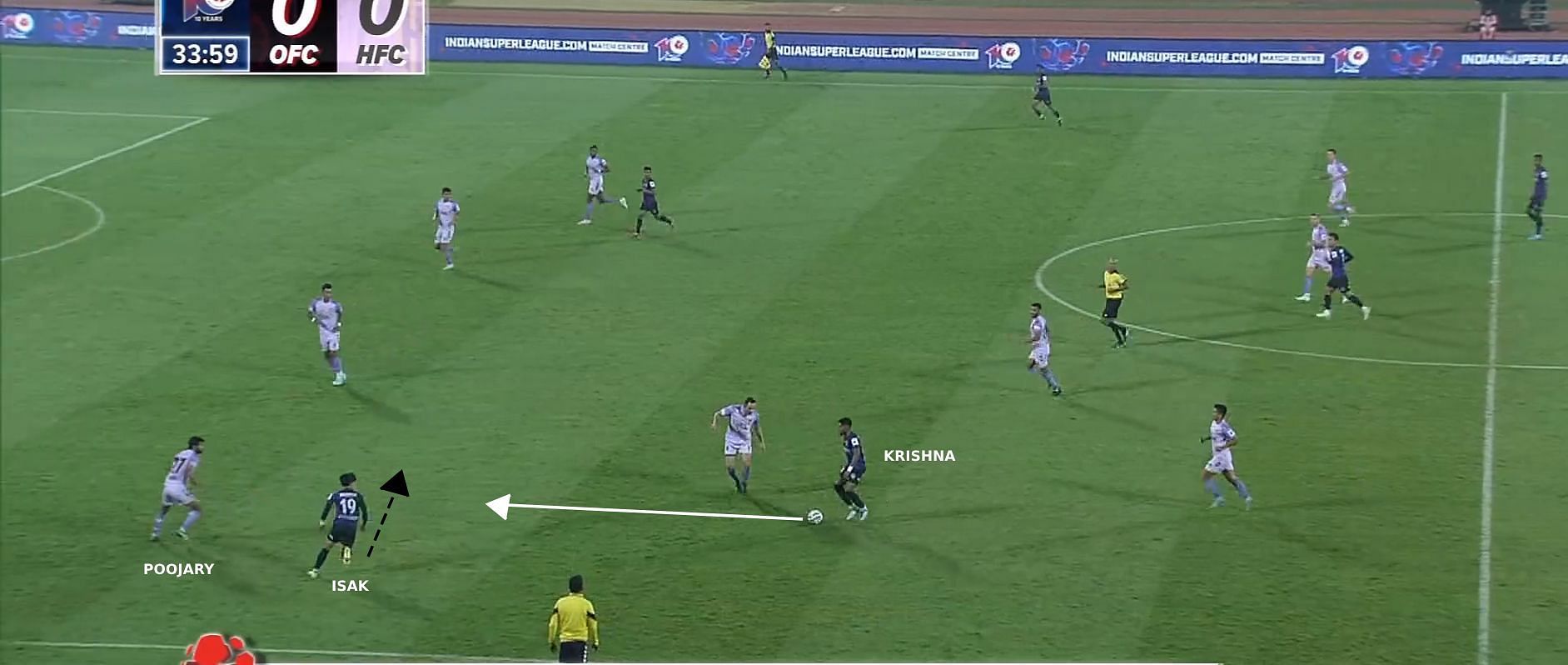
Subsequently, Isak wriggles past two defenders, before setting up Ranawade, who once again exploits space behind the defense. The sequence ends with Ranawade delivering a cut-back to Krishna, who comfortably taps the ball into the back of the net.
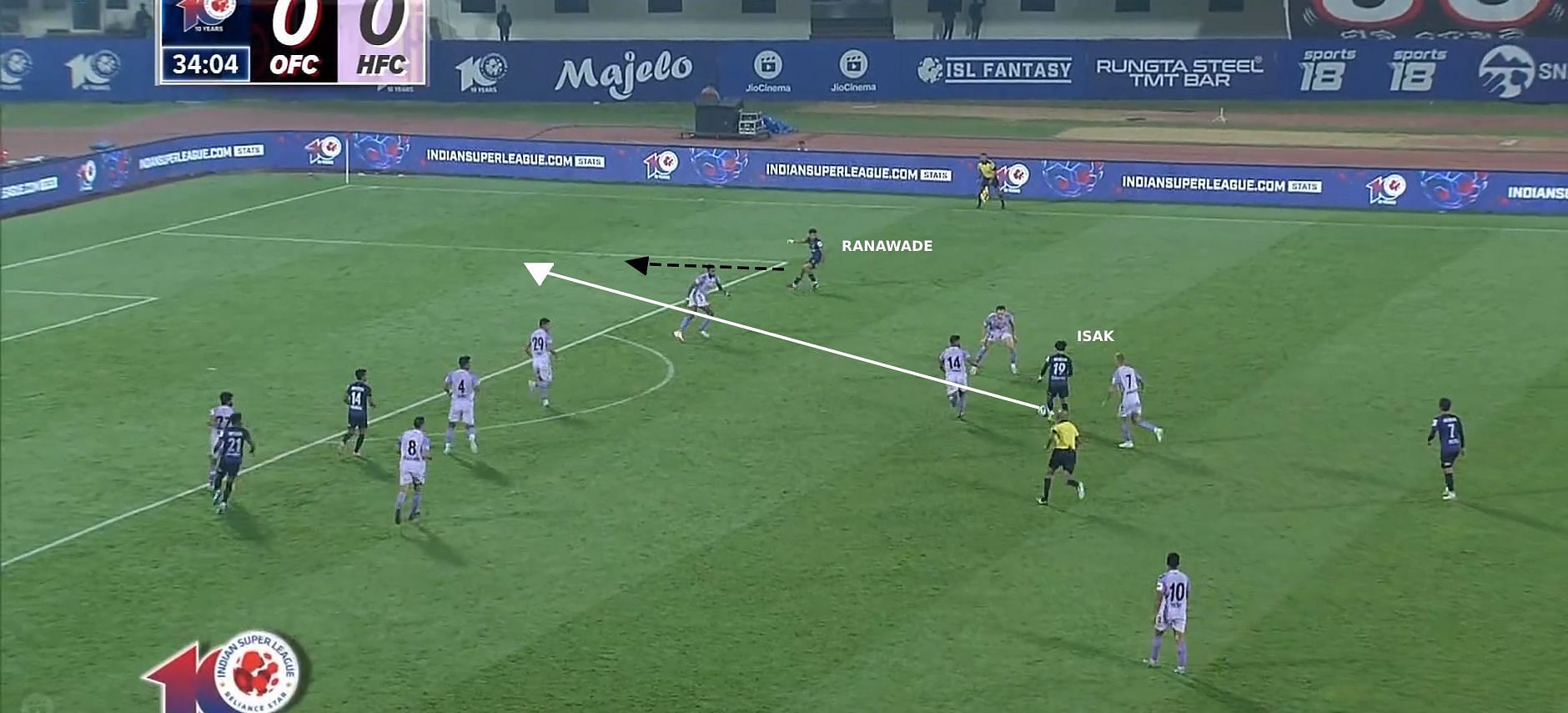
Odisha FC’s attacking duo, Krishna and Mauricio, also play a pivotal role in the team’s build-up and the final third. Their ability to hold the ball and bring others into play is a crucial aspect of Odisha’s success, while they are also equally capable to drift wider or exploit the channels when needed. Moreover, both forwards have been remarkable within the penalty box, as they have been clinical in front of goal.
Beyond their success in open play, Odisha pose a significant threat from set-pieces, amassing a whopping 12 goals from such situations across all competitions (four in ISL, eight in AFC Cup). Notably, Mourtada Fall is their standout player in set-piece scenarios, capitalizing on Jahouh’s precision in deliveries to score seven goals this season.
Despite ranking second-lowest in final-third entries among all teams, Odisha compensate with exceptional accuracy in front of goal. Only Mohun Bagan SG surpasses Odisha in terms of shot accuracy within the league, underscoring their efficiency in front of goal.
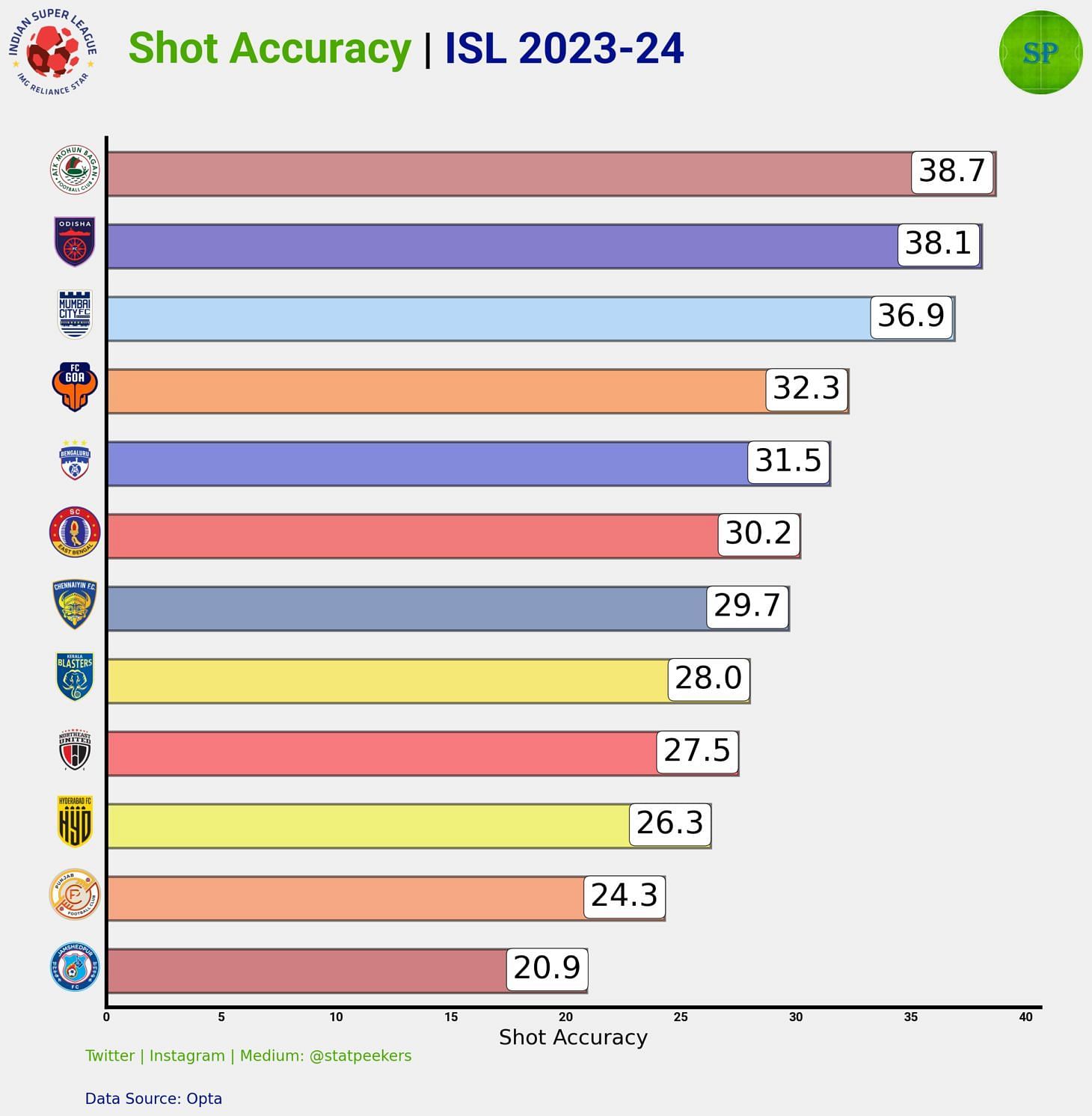
The Juggernauts’ style of football is highly enjoyable, and their recent success is evident, as they have won seven out of their last eight games. They’ve also made history by being the sole Indian team to progress to the knockout rounds of AFC competitions this season.
But the club’s impressive performance is no surprise, given that they possess all the essential elements needed to compete at the highest level. Under Lobera’s leadership, Odisha FC have successfully taken the first stride toward establishing itself as a top-level team by crafting a distinctive identity that resonates with the fans. The trajectory from this point onward is undoubtedly upward.
(All the images were captured from JioCinema app).